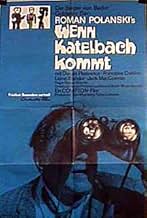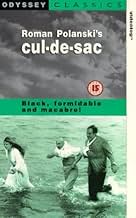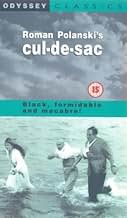Cul-de-sac
- 1966
- Tous publics
- 1h 52min
NOTE IMDb
7,0/10
14 k
MA NOTE
Deux gangsters blessés et en fuite trouvent refuge dans le château isolé d'un homme faible et de sa femme, en quête d'aide ; toutefois, sous la menace d'une arme à feu, les apparences sont t... Tout lireDeux gangsters blessés et en fuite trouvent refuge dans le château isolé d'un homme faible et de sa femme, en quête d'aide ; toutefois, sous la menace d'une arme à feu, les apparences sont trompeuses.Deux gangsters blessés et en fuite trouvent refuge dans le château isolé d'un homme faible et de sa femme, en quête d'aide ; toutefois, sous la menace d'une arme à feu, les apparences sont trompeuses.
- Nomination aux 1 BAFTA Award
- 1 victoire et 1 nomination au total
Jacqueline Bisset
- Jacqueline
- (as Jackie Bisset)
Histoire
Le saviez-vous
- AnecdotesHas one of the longest continuous sequences in cinematic history (at the time of release) at 7 mins 28 secs (the beach scene).
- GaffesWhen Dickie is pushing the car, the shadow of the camera and the cameraman can be seen on him.
- Versions alternativesThe VHS version released in Brazil by Globo Vídeo has exactly 100 minutes.
- ConnexionsFeatured in Le ciné-club de Radio-Canada: Film présenté: Cul-de-sac (1975)
Commentaire à la une
After their car becomes stuck on a causeway, two gangsters named Dickey and Albie find themselves stranded on the remote island of Lindisfarne. There, they take refuge in a castle owned by an eccentric couple, the mentally unbalanced George and his promiscuous and beautiful wife Teresa. The hoods proceed to hold George and Teresa hostage, until their boss Katelbach can send them some transportation off the rock. However, matters become complicated by the arrival of a group of George's friends, one of whom Teresa has an affair with. So begins 'Cul-de-sac,' a tale of madness, sexual frustration and pitch-black comedy that could only have come from the mind of Roman Polanski.
Original, abstract and frequently funny, Polanski's 'Cul-de-sac' is a fascinating, captivating movie that will delight any fan of the dark and strange. Much like his earlier 'Repulsion,' the film launches the viewer into a weird world populated by odd folk struggling with their desires and how to interact with the people around them. The characters engage in a power struggle throughout the film, with manipulation and thuggery being the prime weapons at their disposal. While the hoodlums take George and Teresa hostage, it is also Teresa who makes George a hostage of her lust, and it is she who does the most damage to his psyche.
It is a film that will likely spark differing opinions as to what the meaning of it all is. Some cinema-goers enjoy the guesswork, though others find abstractions infuriating; and 'Cul-de-sac' is not for the impatient or the shunners of philosophy. It's an intriguing, dark thriller that also happens to be one of Polanski's funniest outings, as he injects the narrative with much off-beat humor and sharp, banterous dialogue. The film still features his trademark examinations of paranoia, isolation and social unease; though told in a slightly lighter fashion than one accustomed to Polanski would expect (which, for this viewer anyway, comes as a boon to the proceedings).
'Cul-de-sac' is a visually enthralling flick, featuring arresting cinematography from Gilbert Taylor, who lent his talents to the previous 'Repulsion,' and would go on to work with Polanski once more on 'MacBeth.' Their collaborations made for undeniably artistic and powerful visuals that intrigue and impress, both in creative and technical terms. 'Cul-de-sac' boasts some incredible cinematography, from intense tracking shots to the masterful manipulation of light and shadows; Taylor's distinct and evocative work under Polanski's firm direction is unforgettable.
Alastair McIntyre was a frequent collaborator of Polanski's, and his editing for 'Cul-de-sac' is swift and smart. Reportedly, the two men toiled very closely together in the editing suite, developing over the years an intuitive and fruitful working relationship build on mutual respect and admiration. Looking at the remarkably tight, streamlined final cut of 'Cul-de-sac;' it's easy to see why Polanski utilized McIntyre on six films- his work is nigh on flawless.
Also of note is the score from Krzysztof Komeda, which is jazzy and strangely haunting; like elevator music from Dante's second circle of hell. His melodies fit perfectly the images of the film, as odd and as unsettling as some of them may be. Additionally, Bridget Sellers' rich costume design and George Lack's detailed set decoration and art direction lends the film additional impact and depth to the locales and characters.
'Cul-de-sac' stars Donald Pleasence as George, Françoise Dorléac as Teresa and Lionel Stander as Dickey, with the three of them turning in strong performances that are highlights in each of their filmographies. Pleasence is terrific as the unhinged, deeply neurotic George, imbuing him with an almost childlike quality which makes the character all the more interesting and odd. Though sometimes in films Pleasence had a tendency to go a little over-the-top, here he remains grounded, despite the weirdness of the role; doing consummate work that is hard to forget.
Dorléac- who tragically died before making it as big internationally as her sister Catherine Deneuve- is nothing short of a sensation as Teresa, giving a performance of wit, intelligence and depth that is a real treat to watch. As wily and as seductive as a panther in the night, Dorléac is not afraid to make Teresa unlikable, though she remains charismatic throughout. From her all too short career in film, Dorléac's assured performance in 'Cul-de-sac' is her greatest and most compelling.
Finally, Lionel Stander is brilliant as Dickey, the humorous hoodlum who takes hostage and tries to manipulate George and Teresa. Stander was a talented actor whose screen presence- like Ernest Borgnine- was such that you'd warm to him no matter what he did, evil or nay. With his crooked grin and gravelly voice, he leaves an indelible impression on the viewer; making Dickey a character that is most memorable. The supporting cast all perform admirably too, with a young Jacqueline Bisset and Jack MacGowran impressing the most.
Roman Polanski's 'Cul-de-sac' is a powerful and off-beat thriller that has a lot to offer viewers. Featuring an atmospheric Krzysztof Komeda score, stunning visuals from Gilbert Taylor and a cast performing at the top of their games; there is very little not to praise about the movie. If you enjoy films of abstractions and you have not seen it before, it is advisable that you do so now; as 'Cul-de-sac' is a weird, wild and wonderful movie that is not to be missed.
Original, abstract and frequently funny, Polanski's 'Cul-de-sac' is a fascinating, captivating movie that will delight any fan of the dark and strange. Much like his earlier 'Repulsion,' the film launches the viewer into a weird world populated by odd folk struggling with their desires and how to interact with the people around them. The characters engage in a power struggle throughout the film, with manipulation and thuggery being the prime weapons at their disposal. While the hoodlums take George and Teresa hostage, it is also Teresa who makes George a hostage of her lust, and it is she who does the most damage to his psyche.
It is a film that will likely spark differing opinions as to what the meaning of it all is. Some cinema-goers enjoy the guesswork, though others find abstractions infuriating; and 'Cul-de-sac' is not for the impatient or the shunners of philosophy. It's an intriguing, dark thriller that also happens to be one of Polanski's funniest outings, as he injects the narrative with much off-beat humor and sharp, banterous dialogue. The film still features his trademark examinations of paranoia, isolation and social unease; though told in a slightly lighter fashion than one accustomed to Polanski would expect (which, for this viewer anyway, comes as a boon to the proceedings).
'Cul-de-sac' is a visually enthralling flick, featuring arresting cinematography from Gilbert Taylor, who lent his talents to the previous 'Repulsion,' and would go on to work with Polanski once more on 'MacBeth.' Their collaborations made for undeniably artistic and powerful visuals that intrigue and impress, both in creative and technical terms. 'Cul-de-sac' boasts some incredible cinematography, from intense tracking shots to the masterful manipulation of light and shadows; Taylor's distinct and evocative work under Polanski's firm direction is unforgettable.
Alastair McIntyre was a frequent collaborator of Polanski's, and his editing for 'Cul-de-sac' is swift and smart. Reportedly, the two men toiled very closely together in the editing suite, developing over the years an intuitive and fruitful working relationship build on mutual respect and admiration. Looking at the remarkably tight, streamlined final cut of 'Cul-de-sac;' it's easy to see why Polanski utilized McIntyre on six films- his work is nigh on flawless.
Also of note is the score from Krzysztof Komeda, which is jazzy and strangely haunting; like elevator music from Dante's second circle of hell. His melodies fit perfectly the images of the film, as odd and as unsettling as some of them may be. Additionally, Bridget Sellers' rich costume design and George Lack's detailed set decoration and art direction lends the film additional impact and depth to the locales and characters.
'Cul-de-sac' stars Donald Pleasence as George, Françoise Dorléac as Teresa and Lionel Stander as Dickey, with the three of them turning in strong performances that are highlights in each of their filmographies. Pleasence is terrific as the unhinged, deeply neurotic George, imbuing him with an almost childlike quality which makes the character all the more interesting and odd. Though sometimes in films Pleasence had a tendency to go a little over-the-top, here he remains grounded, despite the weirdness of the role; doing consummate work that is hard to forget.
Dorléac- who tragically died before making it as big internationally as her sister Catherine Deneuve- is nothing short of a sensation as Teresa, giving a performance of wit, intelligence and depth that is a real treat to watch. As wily and as seductive as a panther in the night, Dorléac is not afraid to make Teresa unlikable, though she remains charismatic throughout. From her all too short career in film, Dorléac's assured performance in 'Cul-de-sac' is her greatest and most compelling.
Finally, Lionel Stander is brilliant as Dickey, the humorous hoodlum who takes hostage and tries to manipulate George and Teresa. Stander was a talented actor whose screen presence- like Ernest Borgnine- was such that you'd warm to him no matter what he did, evil or nay. With his crooked grin and gravelly voice, he leaves an indelible impression on the viewer; making Dickey a character that is most memorable. The supporting cast all perform admirably too, with a young Jacqueline Bisset and Jack MacGowran impressing the most.
Roman Polanski's 'Cul-de-sac' is a powerful and off-beat thriller that has a lot to offer viewers. Featuring an atmospheric Krzysztof Komeda score, stunning visuals from Gilbert Taylor and a cast performing at the top of their games; there is very little not to praise about the movie. If you enjoy films of abstractions and you have not seen it before, it is advisable that you do so now; as 'Cul-de-sac' is a weird, wild and wonderful movie that is not to be missed.
- reelreviewsandrecommendations
- 30 nov. 2022
- Permalien
Meilleurs choix
Connectez-vous pour évaluer et suivre la liste de favoris afin de recevoir des recommandations personnalisées
Détails
- Date de sortie
- Pays d’origine
- Site officiel
- Langue
- Aussi connu sous le nom de
- Ćorsokak
- Lieux de tournage
- Sociétés de production
- Voir plus de crédits d'entreprise sur IMDbPro
Box-office
- Montant brut mondial
- 1 500 $US
- Durée1 heure 52 minutes
- Couleur
- Rapport de forme
- 1.66 : 1
Contribuer à cette page
Suggérer une modification ou ajouter du contenu manquant

Lacune principale
By what name was Cul-de-sac (1966) officially released in India in English?
Répondre


















